The boss fights are often the best parts of bullet hell shmups, so Cylor vs The Bullets From Hell cuts right to the chase by focusing entirely upon a single, ever-evolving boss. Over half a dozen difficulties gives this game plenty of replayability and the fight itself has many memorable twists both aesthetically and in terms of gameplay.
As a purely mouse-controlled shmup the controls are a simple matter of holding the left button to shoot and clicking the right button to use a bomb, which refreshes at the start of each phase, but the mechanics behind the fight are more involved. While Cylor must battle a demonic entity in an attempt to reclaim his stolen soul, this boss is not the only enemy which he will fight. Flying eyeballs, bat-spawning bats, centipede monsters and more will all join in the fight as it progresses, but their presence can be a welcome sight as they can drop an interesting trinity of upgrades upon defeat. Upgrades are in nearly every shmup so it’s far from unusual to see them here, but these upgrades have an unusual type of synergy which adds in a layer of strategy when deciding between them. The first upgrade is a heart which restores a single hit point and is the one which you’ll likely pick up the most often since running out of health on lower difficulties results in needing to restart the current phase of the fight without any upgrades and dying in the two highest difficulties is an outright Game Over. The second type of upgrade is a ‘friend’ which acts as an orbiting option, shooting alongside Cylor and, while a single friend might not amount to much, you can acquire an entire ring of these friends to significantly ramp up your damage output, though the maximum number of friends decreases at higher difficulties and getting hit even once makes you lose any friends you have acquired. The final upgrade, the shield, is where things get interesting as this power will mitigate the damage from a single hit and, more importantly, will prevent friends from being lost after taking that hit.
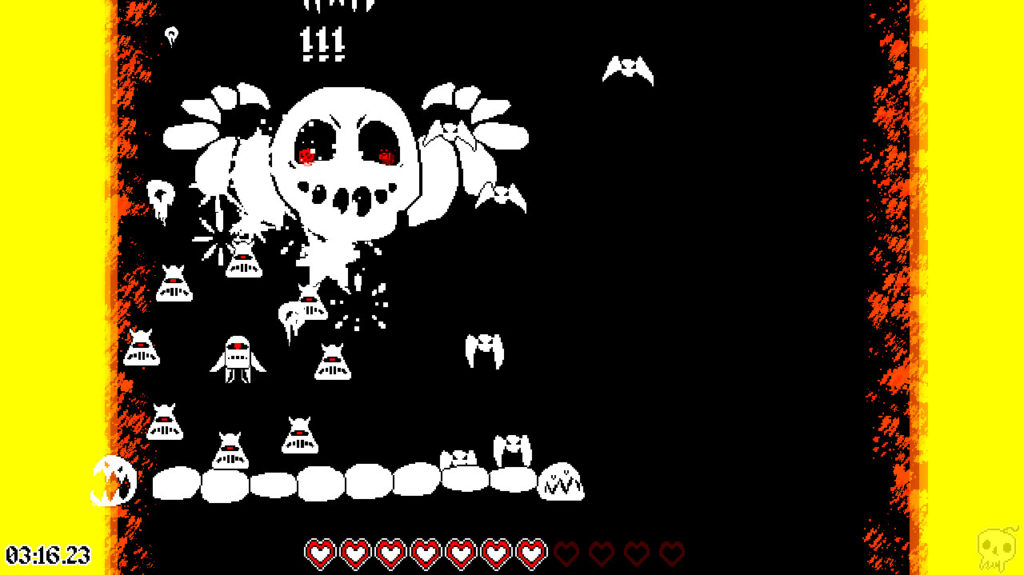
Upgrades can be shot to bounce them upward while also randomly changing them into one of the other two available upgrades, so you have full control over which powers you get as long as you aim carefully. Each choice has advantages and disadvantages over the others and with how crowded the playing field can get you rarely have much time to decide. A heart will keep you alive better than a shield if you’re low on health, but it won’t protect friends, a shield will mitigate some damage and protect friends, but you can’t stack shields and a strong attack might still take away some health, and friends give you a boost to both the horizontal range and the raw damage output of your attacks, but they are fragile. In addition to the three primary upgrades, enemies will also sometimes instead drop evil vortex monsters which slowly home in on you and rare golden eyeballs will always drop four-leaf clovers, which either boost your maximum health or increase the rate at which enemies drop items; clover upgrades are especially valuable because they are permanent, but they will go away if you run out of health. Even the boss sometimes drops unavoidable upgrades between phases, which provide great boosts like higher damage, more bullets, and a faster rate of fire.
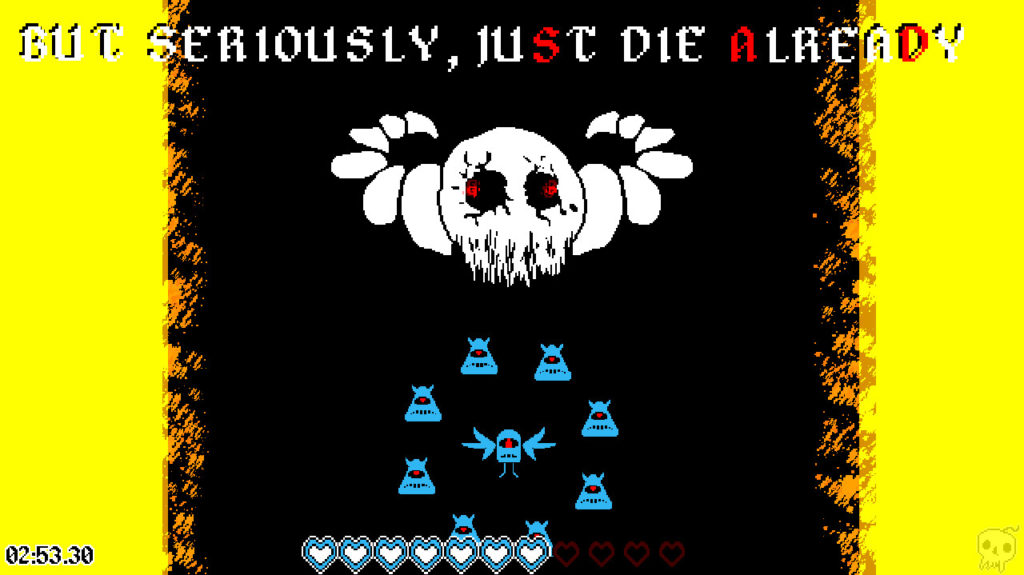
With all this talk of upgrades I have yet to discuss the boss itself. This large resident of Hell has much more in the way of personality than you might expect, issuing forth several lines of dialogue which frequently waver between amused and threatening after each phase while Cylor remains a perpetual silent protagonist. These words initially serve purely as a form of storytelling and characterization, but once the boss begins to take things a bit more seriously they, like nearly everything in this game, evolve to change up the gameplay with various letters turning red and dropping down on the player as hazardous projectiles. As the entire game revolves around repeatedly draining this boss’s health bar it would be easy to assume that it has an impressive array of skills, but it in fact only has three, all of which are fairly simple in nature. These abilities consist of a giant laser launched directly downward from its mouth, a burst of bullets in a circular formation, and the creation of an enormous skull which spins around the boss, acting as a living shield until it is defeated. However, these attacks grow more dangerous over time and build upon everything else. Bullets in the burst become faster and come in larger quantities and the boss is capable of slowly moving left or right while using the laser and the frequency with which he uses this attack increases. Meanwhile, the time you have to dodge falling letters before the boss begins his onslaught of attacks decreases, enemies will pour in from all four sides, your play area will be limited by hazardous pillars of flame on the left and right sides, the boss’s movements will become more difficult to predict, and you’ll even eventually have to deal with the boss blending in with the darkness, becoming invisible aside from his burning eyes.
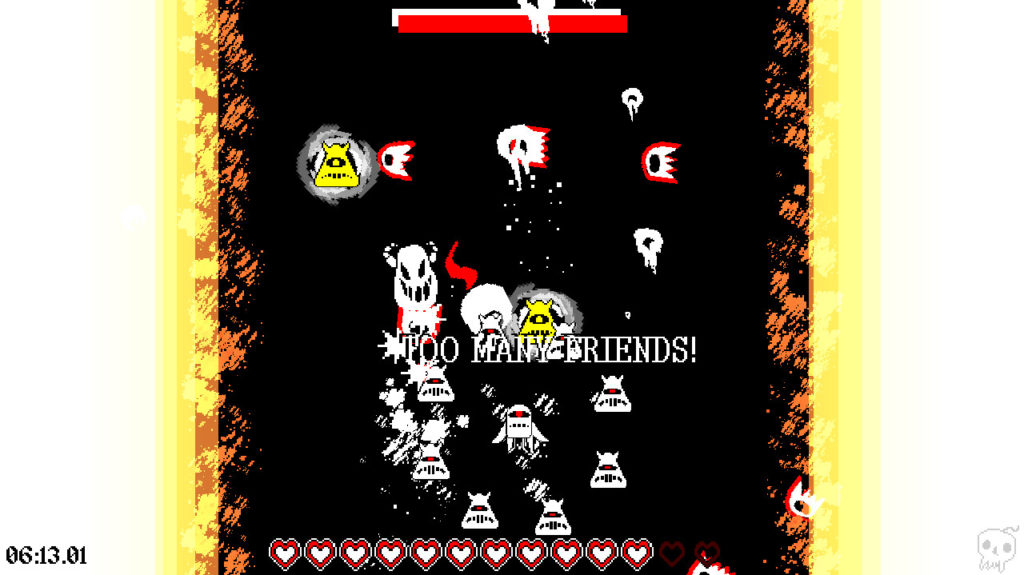
This is a pretty intense fight and it’s only made more intense by the changes between difficulties as there are all sorts of little ways in which the game becomes harder on higher settings. I already mentioned how the maximum number of friends you’re allowed to have becomes lower the higher you crank up the difficulty, but the chance of enemies spawning evil vortexes instead of dropping upgrades upon defeat also seems to slightly increase and the highest difficulty has no upgrade drops at all as far as I can tell. The normal enemies themselves never launch any projectiles so they don’t become more dangerous individually, but they appear more frequently to create larger swarms and the boss himself becomes far more aggressive with more dangerous variations on his attacks. Health is another factor as your initial maximum health is also tied to the difficulty setting to the point that at the highest difficulty you start with a single, shielded heart and the top two, unlockable difficulty settings do not allow for continues, making the health-boosting clovers from golden eyeballs more important than ever.
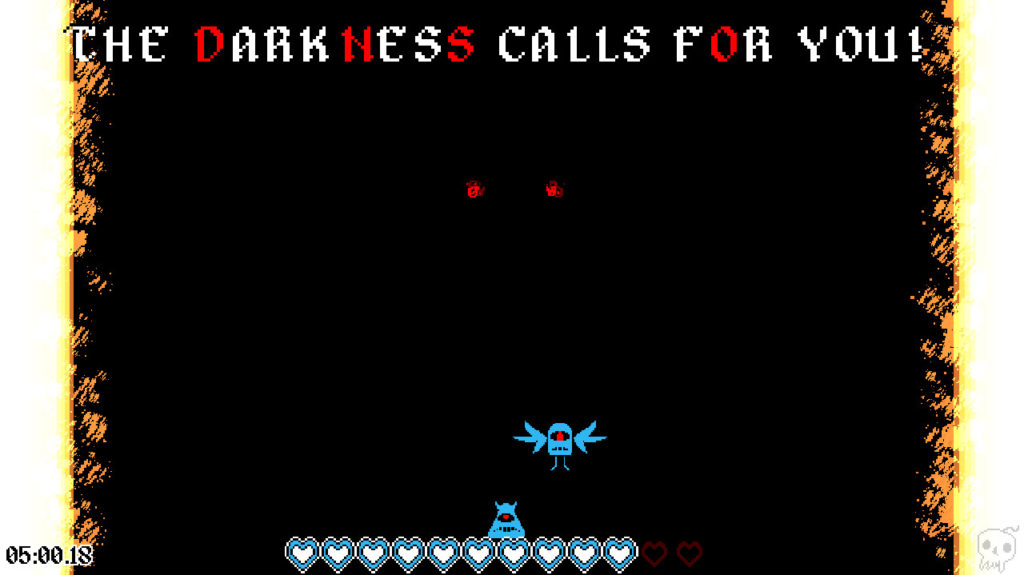
The many subtle and blatant changes between difficulties make Cylor vs The Bullets From Hell highly replayable, made even higher by the fact that the game keeps track of your time and your death count, but not all of the difficulty here comes from positive sources. The largest source of frustration here comes from the UI, specifically the health bar. Placed in the center of the bottom part of the screen, this string of giant hearts is located right where you’ll want Cylor to be while dodging bullets, especially when the sides are covered by flames. Unfortunately, these hearts are also given a higher visual priority than Cylor himself, almost completely covering him whenever he flies near them, leading to the odd effect of your own health bar making it much harder to see incoming enemies and dodge bullets. Another, smaller issue is one of pacing. Specifically, this game is a frantic, delightfully chaotic experience once it gets going as you rapidly defeat one boss phase after another in a matter of seconds while in turn taking fire from all sides while desperately trying to keep your shields up, but the first two or three phases drag even on the highest difficulties. With few enemies pouring in and relatively tame attacks from the boss there’s not much pressure in the early phases, but your own attacks don’t have much weight behind them either and the low number of incoming enemies means an equally low number of incoming upgrades to built up your orbit of optional friends with as you slowly chip away at the boss’s health.
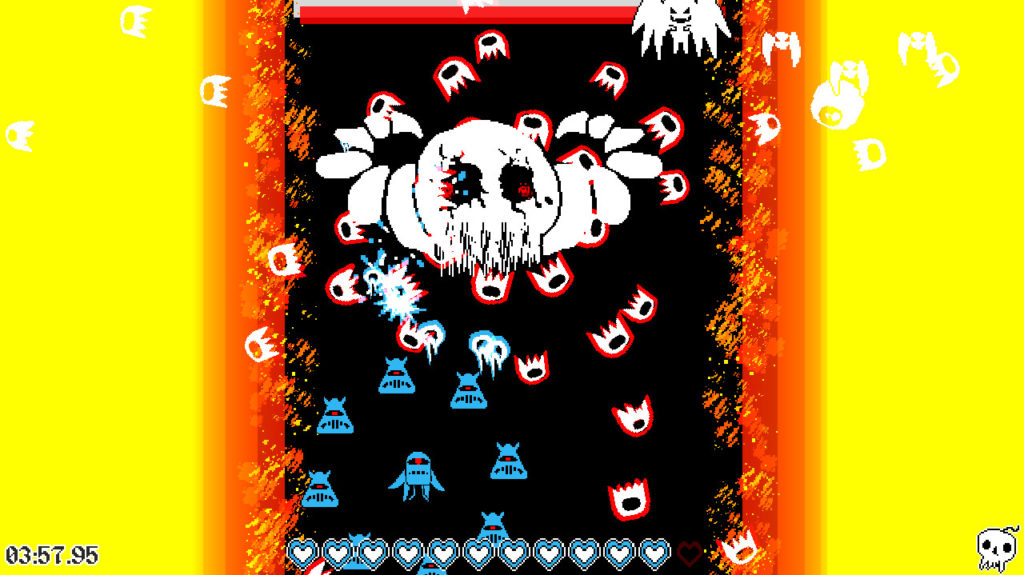
The health bar should be moved somewhere less obstructive to the gameplay (or at least given lower visual priority) and the game could benefit from a reduction in the boss’s health during the early phases, but neither of these issues are deal breakers for what is otherwise a shmup with some very sleek aesthetics, a considerably amount of quirky charm, and chaotic yet solid gameplay which evolves and changes in many small and large ways both as the fight progresses and between difficulties